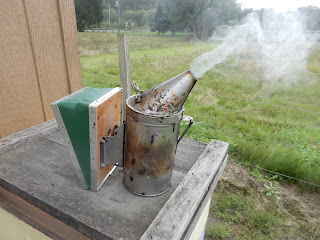Defensively territorial and fiercely protective, each female honeybee is armed with a "sting in its tail,"a strong deterrent for those who would steal her honey or harm her coworkers or queen mother. Beekeepers need a diversionary tool to calm the bees during an inspection or routine maintenance of their hives. Since time immemorial they have used smoke to mollify their charges. Primitive peoples used smoldering chunks of wood to assist them in honey theft. Then there were those old school European beekeepers who wafted cigar or pipe smoke over their bees to calm them.
Back in my halcyon days of beekeeping (I've "messed" with bees since my mid-teens), I read somewhere that when bees are confronted with smoke, they immediately head for their honey stores, begin gorging themselves on their honey stash in order to save it should their home be on fire. An interesting theory to entertain, but I suspect bees react to smoke in much the same way we humans do when campfire smoke drifts in our faces: we immediately shift our positions to clear our eyes and nose of the distracting fumes. Distraction...that's the effect I believe smoke has on bees. Beekeepers employ it to divert attention from their intrusion and send the bees scurrying in the other direction. And here's where the smoker comes into play.
A smoker is little more than a small firebox with a bellows attached to supply more oxygen to the smoldering fuel within. Each compression of the bellows sends a puff of smoke from the smoker's spout. The more expensive smokers come with a heat guard to protect the beekeeper from accidental burns as the firebox heats up in the same fashion as your woodstove (see photo 1). The vent hole at the bottom of the device allows the firebox to draw well and keeps the fuel within smoldering.
When I tend my bees, I always announce my arrival by issuing a few puffs of smoke at the entrance of each colony. Next I pry up the lid and direct a cloud or two of cool smoke across the top bars. This approach sends the bees scurrying down the face of the combs and allows for less interruption when the lid is fully removed. Pop the lid without the smoke and the bees issue an alarm pheromone that the inspector readily smells. A billow or two of cool smoke precludes such a response.
When the bees align their heads between the top bars in a "ready to launch" configuration, a gentle puff or two across the frames neutralizes their launch mechanisms. (A word of caution: the smoker is a tool of combustion and will become a flame thrower if the fuel is superheated; the last thing beekeepers want is to create a blast furnace that will scorch their bees.) I use canvas gloves when inspecting and sometimes give my gloves a good smoking to discourage the bees from taking too great an interest in them.
If you ever see a t-shirt that reads "I smoke burlap," rest assured it's worn by a beekeeper. Burlap is the go-to fuel for a smoke engine: coffee sacks, potato sacks, seed sacks--all work well, burn slowly and provide a nice, cool smoke. Some beekeepers use other fuels to supplement the burlap. I use dry cow "flops," or as I call them, "meadow muffins." This "alternate" fuel must be dry and well-aged.
I gather the bovine by-products in Eastern Washington range land after the cattle patties have sunbaked and lain in the fields for a year or two. Other fuels are wood pellets such as those used for animal bedding or pellet stoves. Forest duff, leaf matter, and evergreen needles are also fuel sources. In the carcinogenically unenlightened days when paper filters were used as vehicle oil filters and folks changed the oil in their own cars and trucks, some beekeepers set the old filters aside to drain and dry and later used them for smoker fuel.
A bee smoker can at times be a cantankerous assistant. Your bees are getting restless. You reach for your smoker to calm them and ah, shucks, it's gone out. Stone cold. And just when it would have come in mighty handy, too. I can think of no better affirmation of Murphy's Law than a snuffed smoker. I've learned to take along extra fuel and matches to the out yard because where the smoker's concerned, if it can go out, it will. And much to the bees' delight and the beekeeper's dismay.
Allow me to introduce my smoke engine. For years it has served me well to the point I've had to replace the bellows recently. It is dented and covered in creosote. I periodically have to scrape the rim and the spout cap to rid the firebox from excess buildup or the lid will seize up and have to be pried open before the next ignition. I've learned never to let it cool with the lid on lest it freeze up and become a frustration.
However, if used incorrectly it can cause a serious burn or singe the wings of your bees. Use caution afield when igniting your smoker, especially during dry weather when you're working an arid out yard. The tool is easily snuffed by stuffing a wad of grass in its snout. Always leave it outside until it's stone cold to the touch. Structure fires have happened because an unwitting beekeeper set a smoldering smoker on the back porch, in the shed or barn. All smoldering, unburned fuel should be doused with water like the campground fire or shoveled under dirt lest a wayward spark ignite something by accident.
The smoke engine, perhaps the most valuable, frequently used tool in the beekeeper's arsenal: whether you're new to the trade or a sting seasoned veteran, don't leave home without it.









No comments:
Post a Comment